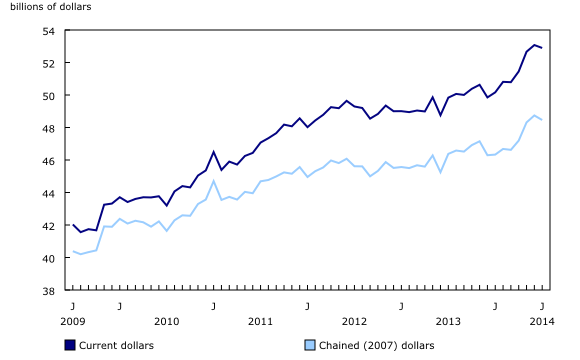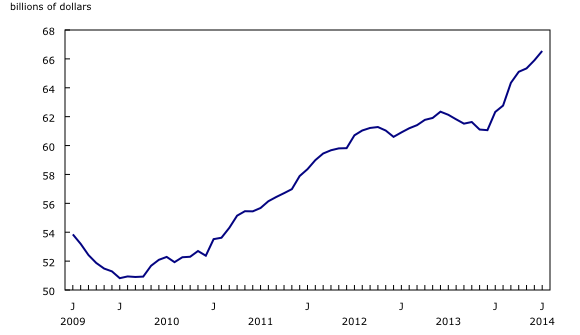Wholesale trade, July 2014
Archived Content
Information identified as archived is provided for reference, research or recordkeeping purposes. It is not subject to the Government of Canada Web Standards and has not been altered or updated since it was archived. Please "contact us" to request a format other than those available.
Released: 2014-09-19
Following three consecutive monthly gains, wholesale sales decreased 0.3% to $52.9 billion in July. Declines in five subsectors, which together represented 81% of wholesale sales, more than offset an increase in the motor vehicle and parts subsector. Excluding this subsector, wholesale sales declined 1.0%.
In volume terms, wholesale sales were down 0.6%.
Lower sales in five subsectors
The miscellaneous subsector contributed the most to the decline in July, falling by $256 million or 3.7% to $6.6 billion, the lowest level in four months. The agricultural supplies industry (-8.1%) was the largest contributor to the decline. The colder and wetter spring weather in the Western provinces contributed to higher than normal sales in June and lower than normal sales in July.
Lower sales were also recorded in the other miscellaneous industry (-5.5%) and the paper, paper product and disposable plastic product industry (-3.8%). The other miscellaneous industry includes wholesalers of logs and wood chips, minerals, ores and precious metals, and second-hand goods (excluding machinery and automotive goods) as well as wholesalers not elsewhere classified.
Sales in the food, beverage and tobacco subsector declined 1.1% to $10.3 billion, mostly offsetting the increase recorded in June. Prior to this decline, sales had advanced in seven of the preceding nine months. The food industry (-1.1%) led the decline in July.
The machinery, equipment and supplies subsector decreased 0.7% to $11.0 billion, following three consecutive monthly gains. Lower sales at the other machinery, equipment and supplies industry (-2.5%), down for first time in six months, as well as the farm, lawn and garden machinery and equipment industry (-1.7%), down for the fourth time in five months, accounted for the decline.
For the first time in 2014, the building material and supplies subsector registered a decrease, falling 0.3% to $7.6 billion. The decline in the lumber, millwork, hardware and other building supplies industry (-2.2%), its first in eight months, more than offset the gains recorded elsewhere in the subsector.
The motor vehicle and parts subsector rose 3.1% to $9.4 billion in July, on the strength of higher sales in the motor vehicle industry (+4.4%). Exports and manufacturing sales of motor vehicles also saw strong growth in July.
Sales down in five provinces
In July, lower sales were recorded in five provinces. Saskatchewan contributed the most to the decline. Ontario and Quebec, two of the largest provinces in terms of wholesale sales, recorded relatively flat growth.
In Saskatchewan, sales fell 6.1% to $2.0 billion in July, the lowest level recorded thus far in 2014. The agricultural supplies industry was an important contributor to the province's decline.
Sales in Newfoundland and Labrador fell 13.3% to $382 million, more than offsetting the gain in June. This was the third decrease in four months for the province.
Following two consecutive months of strong gains, sales in New Brunswick declined 7.5% to $525 million, as a result of widespread decreases across subsectors, led by the food, beverage and tobacco subsector.
British Columbia slipped 0.5% to $5.1 billion in July, a second consecutive sales decline, while Alberta edged down 0.2% to $7.1 billion, its first decrease in seven months.
Ontario rose 0.2% to $25.7 billion, a fourth consecutive increase on the strength of higher sales in the motor vehicle and parts subsector, while Quebec edged up 0.1% to $9.6 billion, a third consecutive increase.
Sales in Nova Scotia rose 2.0% to $758 million, a third increase in four months. The gains were widespread across subsectors.
Inventories increase in July
Inventories recorded a seventh consecutive gain in July, rising 1.0% to $66.5 billion. Gains were recorded in all subsectors.
The largest gain in dollar terms was in the motor vehicle and parts subsector (+2.9%), a second consecutive increase.
The building material and supplies subsector (+1.1%), the personal and household goods subsector (+0.6%), and the food, beverage and tobacco subsector (+1.2%) all recorded a fifth consecutive monthly increase. In addition, inventories rose for the sixth consecutive month in the miscellaneous subsector (+0.9%) and a seventh consecutive month in the machinery equipment and supplies subsector (+0.2%).
The inventory-to-sales ratio increased from 1.24 in June to 1.26 in July. The inventory-to-sales ratio is a measure of the time in months required to exhaust inventories if sales were to remain at their current level.
Note to readers
All data in this release are seasonally adjusted and in current dollars, unless otherwise noted. For more information on seasonal adjustment, see Seasonally adjusted data – Frequently asked questions.
Total wholesale sales expressed in volume are calculated by deflating current dollar values using relevant price indexes. The wholesale sales series in chained (2007) dollars is a chained Fisher volume index with 2007 as the reference year. For more information, see Sales in volume for Wholesale Trade.
The Monthly Wholesale Trade Survey covers all industries within the wholesale sector as defined by the North American Industry Classification System (NAICS), with the exception of oilseed and grain merchant wholesalers (NAICS 41112), petroleum and petroleum products merchant wholesalers (NAICS 412) and business-to-business electronic markets, and agents and brokers (NAICS 419).
The July 2014 issue of Wholesale Trade (Catalogue number63-008-X) will soon be available.
Wholesale trade data for August will be released on October 20.
Contact information
For more information, contact us (toll-free 1-800-263-1136; 514-283-8300; infostats@statcan.gc.ca).
For analytical information, or to enquire about the concepts, methods or data quality of this release, contact Elspeth Hazell (613-951-8090; elspeth.hazell@statcan.gc.ca) or Marco Morin (613-951-2074; marco.morin@statcan.gc.ca), Manufacturing and Wholesale Trade Division.
- Date modified:



